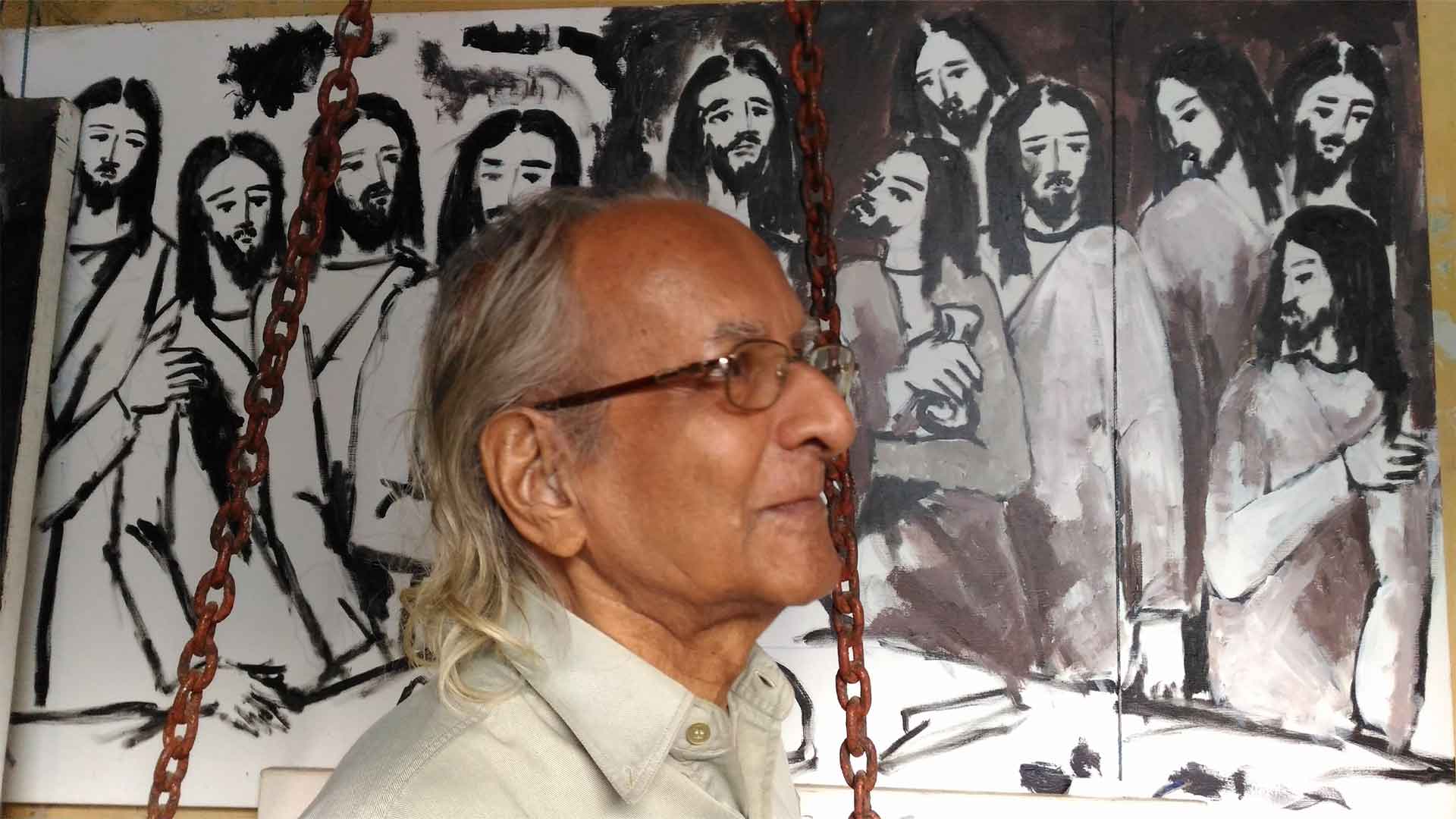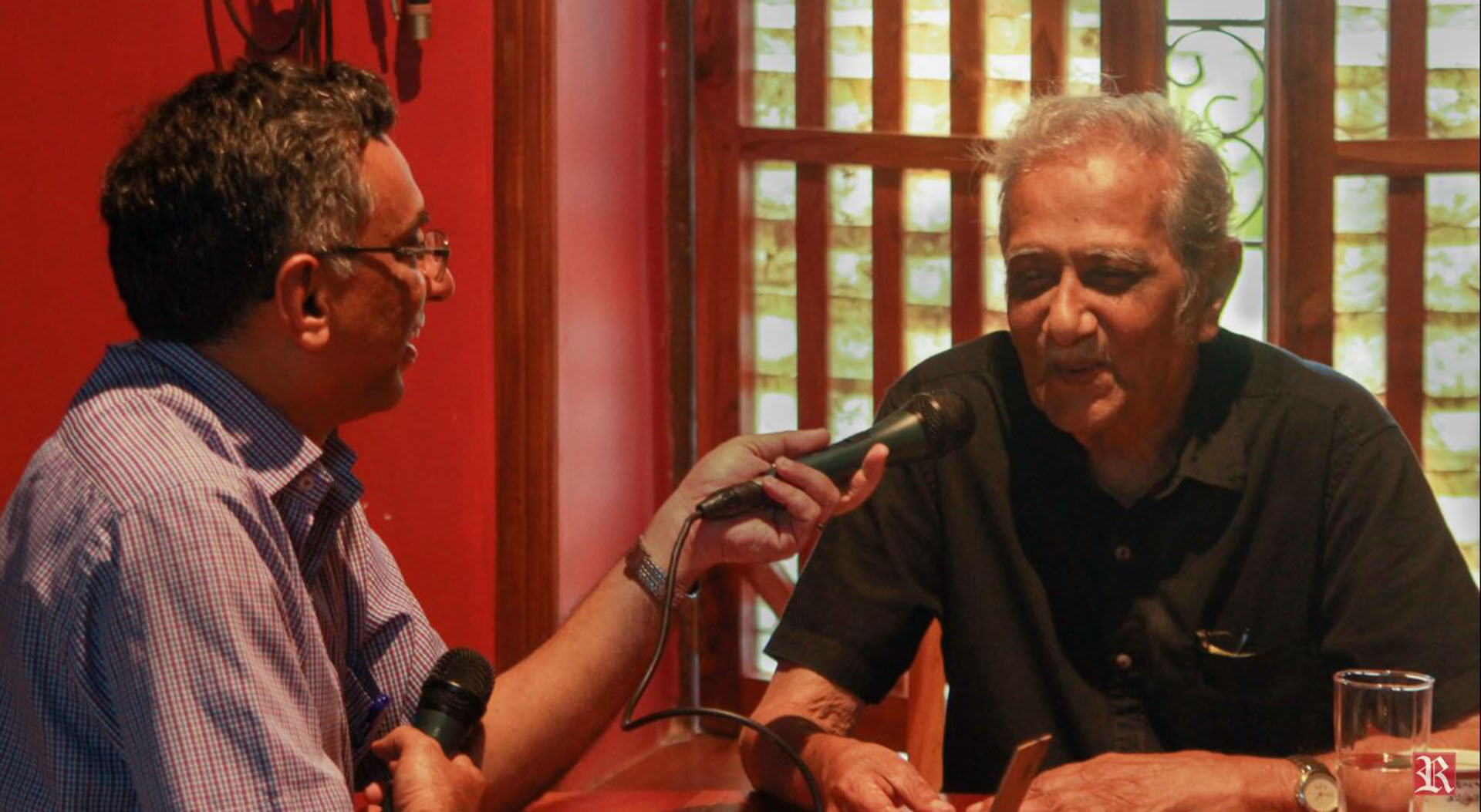Navelcar, aka Ganesh
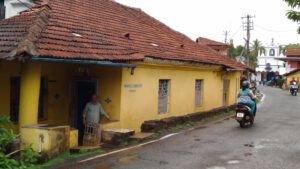
On a rainy morning in June [2018], we went up to the village of Pomburpa, taluka of Bardez, on a visit to the well-known Goan painter, stained glass designer and ceramist Vamona Ananta Sinai Navelcar, whose pen name is Ganesh. Despite his grey hair, he was a picture of rare vitality, and in this chat he comes across as enchantingly feisty. He invited us to see the inner patio of his house which doubles as his atelier.
For the original chat show in Portuguese, see https://www.youtube.com/watch?v=rMgblHr5gk4&t=1s
ON: We are face to face with a canvas [Last Supper] that you are working on… I suppose it’s your most recent work...
VN: I started it a week ago and have to deliver it in the next two days...
ON: You work at top speed!
VN: It feels good to work. I have worked on many Last Suppers – more than 30, in Portugal and here…
ON: Do have a penchant for Last Suppers?
VN: Yes, for Christ! At 8 years of age, I used to read the Bible in Konkani. I was surprised to see what a fine figure Christ is! I became more of a Christian ever since, a disciple of Christ indeed. I think I have nothing of Hinduism, nothing, and I belong totally to Christ…
ON: So you have a relationship...
VN: Yes, yes, there is a mystic relationship between me and Christ.
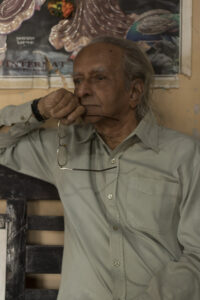
ON: Will this canvas too be signed ‘Ganesh’?
VN: Always Ganesh. None of my paintings bear my name alone. It could bear my name but this is always followed by ‘Ganesh’.
ON: Why ‘Ganesh’?
VN: Ganesh was my elder brother, who died at 16 when I was 8 years old. He was my guide.
ON: Did he inspire you to paint?
VN: My father wouldn’t allow me. He wanted me to be a doctor – like Hindus always do. I used to paint on the reverse of the calendars and would hide them when he came.
ON: Do you still have those calendars?
VN: No longer. After so many years… Well, now they would have been worth a lot.
ON: Indeed. But what was your father’s grouse against painting?
VN: I think the Hindu community holds art in contempt.
ON: Well, the Hindu civilization has great works of art to their credit… Ajanta and Ellora, for example, and so many other places.… Why the contempt, then?
VN: They are materialistic... What money does art fetch you? Medicine does!
ON: If not an artist, what would you have been?
VN: If not an artist today, I would have continued to be an employee of Chowgule’s…. After Matriculation, I began working there; I came across many people, until one day came the inauguration of the Chowgule Mines. Chowgule asked me to draw two portraits: one of him and other of the Governor. I did so. At the inaugural ceremony, the Governor asked the painter’s name; Mr Chowgule said it was one of his employees. I was called. The Governor was Bénard Guedes… the first thing he asked me was if I would like to study Art. If so, I could go to Portugal, but I said I would prefer Sri Lanka or Karachi… He said I should go to Portugal, and I said no. He then gave me a month’s time to decide, and thus I felt compelled to leave for Portugal. I couldn’t speak Portuguese very well then.
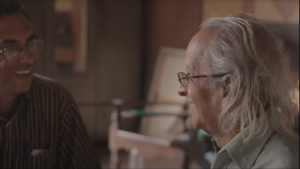
Stay in Portugal
ON: Did you complete your Lyceum in Portugal?
VN: There I did the 5th to the 7th Years of Lyceum; I did it in two years.
ON: After the Lyceum, did you move on to the School of Fine Arts? And how long was the course?
VN: It was a five year course. First it was the general course, then the complementary course. And for the admission test, one day as I was practising drawing, the teacher commented: ‘My friend, your drawings are poor. It won’t be a good idea to answer the admission test this year.’ After a week or so, he had a different opinion. My colleagues too were surprised to see a big leap forward from my first drawing. I stood second in the admission test.
ON: How was the Fine Arts course?
VN: Good. But those teachers knew nothing about other arts, the Oriental arts, Chinese and Japanese; and that India is another world, with a different culture. There was, however, a brilliant teacher, architect Frederico Jorge, who said ‘You have an original palette, and bright colours! You have a style of your own. Follow your path.’ Then came the Invasion or Liberation of Goa, or whatever you call it. I was stumped when a Goan asked me a very roguish question. I told him that I had nothing to do with Goa, and that the Goans were to blame for whatever had happened, for they never spoke their mind but remained mum. My scholarship was cancelled; they wanted me to speak out against India. Why would I speak out against India?
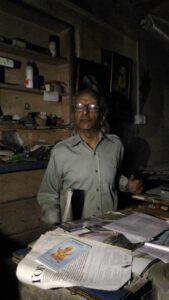
ON: After that you went to Africa…
VN: I had to, because the Government had cut off my scholarship, and there, instead of being posted in Lourenço Marques, I was sent to Nampula. I was stuck there for nine years, without a transfer. The Director lamented that despite being the best qualified teacher I was posted up north.
ON: That was politically motivated, wasn’t it?
VN: Yes, but I wasn’t disappointed. Truth always prevails.
ON: Satyameva Jayete [em sânscrito: ‘A verdade sempre triunfa!’].
Teaching career
ON: Were you happy to be a teacher?
VN: Yes. My aim was to understand the student’s technique or to guide them in using their technique, with none of my influence. Or else, they would just be a carbon copy of the teacher…
ON: Well, you let the student enjoy all the freedom!… And how did Africa influence you?
VN: Yes, there is an inadvertent influence of Africa on my paintings.
ON: And what about the people of Africa?
VN: They are a fantastic lot. To me, Africa is the land of Christ…
ON: In what way?
VN: To me, each African face is the face of Christ. Even while in Portugal I didn’t feel any Christian influence as I did in Africa…. Africa is Christ’s Paradise.
ON: That’s a nice expression… Did your style evolve?
VN: Yes, there has been an evolution; and I never repeat myself. What I draw today and tomorrow is completely different.
ON: Do you paint only on canvas?
VN: Really speaking, my specialisation is Stained Glass, a very difficult technique.
ON: Which would you regard as your greatest painting?
VN: None. I’m never happy with my work. I draw but am never happy. I do one and am not happy, another, and still not happy. Some say ‘this work is better than that work’ but I’m never happy with what I’ve done, never! And the day I begin to feel that I’ve done my greatest work it will spell defeat. ‘I am nothing, never shall be anything.’ These words of Pessoa opened the path of my life.
ON: What’s your work schedule? Are you at it every day or only when you feel like it?
VN: I am practically always at work, either drawing or painting.
ON: They say you used to sign your works as ‘Ashok’.
VN: That was in the 1950s and 60s; now it is ‘Ganesh’.
ON: Are there any particular colours that you like best?
VN: Blue, which is spiritual; and red, which represents violence.
On Three Continents
ON: You've been called "an artist of 3 continents". Did you travel a lot?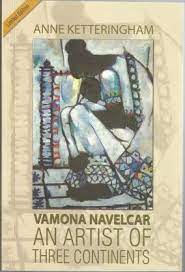
VN: No; Portugal, England, a bit of France, Italy…
ON: Which artists do you admire?
VN: Picasso, Braque, Matisse, Cezanne, Van Gogh…
ON: Do you think artists are different from others, think differently?
VN: Yes. They have a different perspective.
ON: It’s clear that you are a sincere man, and you like to stick to the truth.
VN: I speak the truth, and that’s why I find myself in the present condition; if not, I would have advanced further.
ON: But your work will be remembered for ever!
VN: Do you think so? My position as an artist is significant. But what has the Government of Goa done for me? Nothing! Today I would have preferred to be in Africa and never to return to Goa, never! It’s terrible. I acknowledge my defeat for having returned to Goa. I have to be frank, right?
ON: Oh yes! What were the other options open to you?
VN: To go to Africa and to stay there.
ON: Are you still in touch with your students?
VN: Yes, with many of them. The Mozambican Minister of Foreign Affairs, Armando Panguene, is a great friend of mine. And his wife was my student at the Lyceum. She is not an artist. She is an Ambassador. A very good lady. She is Armanda, and he is Armando…. When I speak of Mozambique… I get that fever. Wanted to go there…
ON: What was your most memorable experience about Mozambique?
VN: Fraternal friendship.
And as we were about to leave the lovely inner patio of the Navelcar house in Pomburpa, the Master said:
VN: This place is my everything: it is here that I read, sleep, rest…
And we soon got into other details of the Artist…
Navelcar Family
ON: How old is your house?
VN: More than 400 years old.
ON: Is your family from Pomburpa or settled here?
VN: My family hails from Navelim, Divar. They settled here four hundred years ago.
ON: So you were born here, started painting here, and grew up here... And which was your favourite spot?
VN: It was right here.
ON: Well, we find ourselves precisely at the spot of your inspiration…
VN: (Smiles) We would sit here, open these doors and contemplate the rain clouds flying over the house, creating forms that I would relate to the legends of Ramayana and Mahabharata. That influence exists in my works.
ON: Do you like music?
VN: Of course, don’t even talk about it! Western classical music, Mozart, Tchaikovsky…. and the Fado. ‘Aquela janela virada para o mar’ (‘A window with a view of the sea’)… Mourão… and many others… Amália Rodrigues…
ON: And well, here is a window with a view of the river!…
VN: Precisely. I remember Amália. ‘Aquele moreninho’, she would say. When I wasn’t there she would inquire about my whereabouts… She was a simple person, without any airs.
ON: So you knew her personally. Did you meet her when she visited Goa [in 1990]?
VN: Yes; and I offered her a drawing of mine, at the Kala Academy.
ON: So, when did you leave Portugal for Goa?
VN: In 1976. It was a big mistake…I’ve got some friends there. Very good people!
Personal Preferences
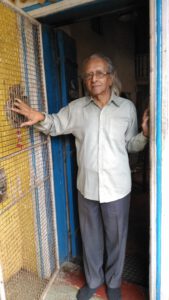
ON: What is your favourite food?
VN: Bacalhau [Gomes] de Sá, sausages, too, and beef.
ON: Well, thank you very much for your time, friendship and generosity.
VN: Today is a very significant day. I am here with friends who have deep friendship towards me and towards Art. Hope this will not be your last visit…
ON: Surely not!
VN: I am very grateful to you for your visit.
ON: The pleasure and honour is ours.
VN: And mine too!
(First published in Revista da Casa de Goa, II Series, No. 14, Jan-Feb 2022)
Early days of Mining in Goa
Mining activity changed the face of Goa, says Manuel (Manecas) Costa, one of Goa’s senior-most mining concessionnaires, in a chat with Óscar de Noronha, on the monthly Renascença Goa show.
O.N. – Mr Manuel da Costa, to start with, please tell us how you got into the mining business.
M.C.: I was studying in Belgaum and I returned to Goa in the year 1952. Here, many people were talking about mining and the extraction of iron ore. I was quite interested in those conversations. I started a business of transportation of ore as there was a shortage of trucks. In fact, there was a shortage of all machinery for mining. I started with five lorries to transport mineral. In the first year I transported iron ore from M. S. Talaulikar Mines, from Sacordem to Collem railway station. Then I received another proposal to transport iron ore from Pissurlem. For the payment, Mr Vasudev Salgãocar came with his employee named Parkot who carried a small brief case full of money. In those days everything was limited because of a lack of finance. He came in a small car, Baby Austin. He was also in the beginning of business. And that year, I was informed that he extracted only 60,000 to 80,000 tonnes.
O.N. – Which year are you talking about?
M.C.: 1953 or 1954. Thus I launched into the mining business. When I went with my lorries to the mines, I used to observe the manner in which the material was extracted. I saw them separating the ore according to percentage. They extracted manually, everything by hand, with manual labour, as there was no machinery. Later on, I bought a compressor with a drilling attachment. And that is how everyone else also went on improving their mining extraction.
O.N. – Did this extracted ore already have a commercial demand?
M.C.: In the year 1954 or 1955, the exporters, namely, S. Shantilal, Vasudev Salgãocar, Chowgule, and some others were invited to Europe for consultations on financing by barter system. Under the barter system, ore would be exported from Goa. The purchasers had other agencies that were financiers; they were the intermediaries to ascertain that the ore would be furnished from Goa. For example, V. M. Salgãocar had a contract with Ciba, who were into pharmaceuticals. They probably also had other activities. Ciba had a representative based in Goa to observe and ensure that Salgãocar would carry out the whole contract. With the barter system it was advantageous for them because they managed to purchase lorries and other necessary machinery. Salgãocar imported a shipload of Bedford trucks, and so did Shantilal and the other companies who also bought trucks and thereby improved their transportation system. Thus they improved their situation. However, business was limited and the prices were low, extremely low. As the work was manual, the sourcing and extraction of ore was limited and so exports were limited, too. The rates were low, so we had to organize our business in such a way as to manage to get some profits. The exchange rate was two rupees to the dollar. However, the other materials were cheap. For example, petrol was @ 10 paise per litre and diesel @ 8 paise per litre. Labour wages were standard but low as compared to today. And that’s how our business went on.
Mining Laws and Processes
O.N.: Mr. Costa, when was the first law of mines decreed?
M.C.: It was the Declaration of 1906.
O.N.: And when did mining activity begin?
M.C.: Surveys were being carried out. In 1908, a French company from Calcutta came to Goa to carry out a geological survey. As they didn’t have the machinery that we have nowadays, they opened a tunnel digging up to 4-5 metres.
O.N.: In which part of Goa was the tunnel?
M.C.: There dug two or three tunnels in Mulgao, Bicholim. Subsequently, six claims were put up by M. M. T. de Souza.
O.N.: Did the land belong to the Comunidades or to the State?
M.C.: This I don’t know; maybe partly private and partly State.
O.N.: When was the first concession given to Mr De Souza?
M.C.: In 1941.
O.N.: From 1908 to 1941... Well, that was quite a long interval!
M.C.: It was a long interval, but I had heard that one Mr Pereira from Vasco da Gama also had a concession in Sacordem or somewhere around there and had been extracting ore much before 1941.
O.N.: How were these concessions granted? What was the process?
M.C.: In those days, unfortunately, money was in short supply. If anyone had a hundred rupees, everyone around would say, ‘Oh! Here comes a capitalist’. To get a license for mines, four or five guys used to get together and contribute Rs 50, Rs 40 and Rs 20 and put together Rs 200. Then they could apply to the Government for a mining concession.
It was a simple process. All the local demarcation points had to be made. The person who applied had to fix a plaque in one or two places. Thus people could read the name of the person who had applied. These nameplates were fixed on trees or some visible spots. And the sign had to mention that so and so had applied for a ‘claim’… using this word, ‘claim’…
O.N. You mean the word ‘claim’ in English?
M.C.: Yes, claim for this plot for extraction of iron, manganese or something to that effect. The sign plate would remain there for some time. After the application was made, the government would publish in the official gazette that that particular area had been applied for by so and so person, giving 180 days for anyone to file any appeals. After this time had lapsed, the government would issue a certificate of manifest. The people holding these manifests could approach different individuals and offer to sell them for a better price. These were sold for a profit of two hundred or four hundred rupees. The person who bought the manifest would then continue the process of registration, which cost less than a thousand rupees. Thus they would manage to get a title of concession.
O.N.: Was this title of concession for life?
M.C.: This title of concession was a perpetual lease, as if it was your personal property. The person would be the owner of the concession.
O.N.: Were there any other conditions and charges? How did he pay the State?
M.C.: During those days, the Portuguese charged a pittance. Even during the exploration, the charges were not very high. Many people took this initiative because the process was more liberal.
O.N.: What about technical personnel?
M.C.: Well, in those days there were hardly any technicians. Even big companies did not have competent technicians or geologists. There were some companies who were assayers to analyze the ore and determine the percentage of iron and manganese content in the ore. But there were no proper machines to determine what was lying below the soil. It was difficult due to the lack of proper machinery; however, two or three companies brought geologists from Germany, etc. That was a novelty in those days.
O.N.: Where was this ore exported to in those days?
M.C.: Initially it was meant for Europe, but soon thereafter, the Japanese came and met some mine owners here, especially Chowgule that tied up for a long association with that Japanese company. In those days, Chowgule was in the initial stage of their business and so was the Japanese company, as their business had been badly destroyed by the Second World War.
O.N.: Was the mining industry well established and organized? I mean, was there any association of miners?
M.C.: No, almost none.
O.N.: Did they not have an association during the Portuguese regime?
M.C.: There wasn’t any, nor was it necessary.
O.N.: And when was the Goa Mineral Ore Exporters Association set up?
M.C.: The Exporters Association came up well after Liberation. The Goa Mining Association also came up later.
Benefits of Mining in Goa
O.N.: What were the benefits of the mining industry for Goa?
M.C.: In Goa, around the 1950’s, there were no industries. There were agriculturists, etc. Some people worked on ships or proceeded to Bombay for other employment. There was no room for progress. Schools were limited and studies were in the Portuguese language.
O.N.: So, the mining industry came and changed the face of Goa….
M.C.: Yes, mining changed Goa in a big way. There were great changes, because normally the mines were located in the interior. And where there were mining deposits there were no proper roads, especially in the districts of Bicholim and Satari, Dharbandora, Sanguem and part of Quepem. In Canacona, there wasn’t much mining. All these districts that I just mentioned were part of Novas Conquistas (New Conquests). The Velhas Conquistas (Old Conquests) were more advanced; there were proper roads, cities with electricity, etc. and life was more comfortable. But the Novas Conquistas really needed much help. There were no proper schools, no proper hospitals, almost no transport and there were no roads for transportation. For example, there was a road from Mapuçá which passed through Sanquelim, Bicholim via Usgão, came to Pondá and proceeded to Margão. They were mud roads without asphalt and the journey was very uncomfortable. Nowadays, if there is a pothole here or there, there are protests all over the place. They do not know the difficulties we went through.
O.N.: So, in the initial years of mining, it wasn’t a simple life!
M.C.: It was quite hard not only because of the lack of transport but our lifestyle itself was totally different. There was nothing to eat and drink in those areas, and one had to travel at least 6 km to get a cup of tea.
O.N.: Were you staying at the mines?
M.C.: Yes, I was. I had a small little hut. And when I built the house, I also had my supplies. But also the work increased tremendously. One had to go from the mines to the point of embarkation where the barges were loaded. All the work was manual. Later on these docks were mechanized and they were loaded with self-loading trucks. Of course, in my time, to load up a barge of 250 tonne capacity, we needed 200 people. They used troughs, which were loaded with material and carried on the head and dumped in the barge over a gang plank/jetty which was made of wood. It was a temporary structure. Fortunately, the laws were not so rigorous. Today, to do something, it requires at least five to fifteen licences. My ore would be transported over a distance of 6-7 km to the jetty. The lorries were loaded and discharged onto the barges, again by hand. I used to be paid only Rs 11 for a tonne of ore. But then, that was money in those days!
Getting out of the Impasse
O.N.: Mr Costa, the mining industry has reached an impasse. How does one come out of it?
M.C.: Very difficult. In 1987, when our concessions were converted into mining leases, we the miners referred the matter to the Supreme Court, explaining that we had perpetual leases which were ours personally. Unfortunately, the case has not yet been taken up for hearing by the Supreme Court.
O.N.: Do you still work?
M.C.: Oh yes, I still work. I mean, even though the mining business has been discontinued, there is still a lot of work left to be done; we still have to handle many of the issues.
O.N.: Working is good for health!
M.C.: Yes, I agree, it’s very good for health!
O.N.: One last question… What if you had to start all this work in mining once again…?
M.C.: Under what conditions? Today we are quite advanced in the exploration of mines. We know the mining laws. But I saw what happened in the years 2005, 2006 and 2007, when the demand for iron ore increased, the way the local people and the NGOs acted. If we restart the business, we know what to expect.
O.N.: Anyway, you have done what was possible and what needed to be done; you’ve worked 50 years in mining and are the oldest man in the Goa mining industry….
M.C.: One of the oldest!
O.N.: And so, let me wish you good health and lots of happiness.
M.C.: Thank you very much.
Translated by Caetano Filipe Colaço
First published in Revista da Casa de Goa, Series II, No. 10 (Jul-Aug 2021)
Use the following link to listen to the original chat in Portuguese on the YouTube channel of Renascença Goa:
https://www.youtube.com/watch?v=FtqG5bONwWs&t=1641s
